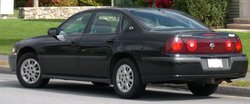Chevrolet Impala
|
|
The Chevrolet Impala is a sedan-based automobile developed and built by the Chevrolet car division of General Motors. Ed Cole, Chevrolet's chief engineer in the late 1950s, defined the Impala as a "prestige car within the reach of the average American citizen."
| Contents |
Pre-1958
The Impala was originally a Corvette-based prototype car in the early to mid fifties. Many Chevrolet models originated as Corvette-based experiments. Examples include the Corvair & Nomad. The Impala originated as a sports coupe, and was the least Corvette-like of the few because it wasn't introduced with the originals.
1958-1972
ClassicCar6.JPG
Photo_73impwagonangie.jpg
The Impala was introduced in 1958 as a new up-level, sporty trim package created for Bel Air coupes and convertibles. Unique to the model were its six taillights, a classic styling cue that became its trademark. It was named for a southern African antelope. The Impala became a separate model in 1959 in both two and four-door versions and became the best selling car in the Chevrolet product line. For 1960, it became the best-selling automobile in the United States and held that position for the next decade. From 1958 until 1996 Impala passenger cars resulted in sales in excess of 13 million units, more than any other full-size car in the history of the automobile. In 1965, the Impala set an all-time industry annual sales record of more than 1 million units, which has never been bettered.
The Impala is often credited with starting the muscle car era. In the 1960s, gasoline was cheap and consumer demand for power exceeded the need for efficiency. Buyers were clamoring for as much room, performance, amenities and quality as they could get for their dollars. In 1961 the first true muscle car was introduced with the Impala SS or Super Sport. The SS badge was to become Chevrolet's signature of performance on many models. The SS package in 1961 was truly a performance package. Nothing less than the high-performance 348 cubic inch (5.7 litre) engines or the new 409 in³ (6.7 L) could be ordered. The 348 options were 305, 340 and 350 horsepower (230, 255 and 260 kW) engines. It consisted of upgraded tires on station wagon wheels, springs, shocks and special sintered metallic brake linings. The Impala SS could be identified by SS emblems on the rear fenders and trunk lid. The Impala SS became its own series (separate model rather than an option package) for 1964. A 1967 Chevy Impala was the focus of a (debunked) Darwin Award in the JATO Rocket Car story.
1973-1985
The 1970s showed a change in the U.S. view of the automobile. The impact of the 1973 oil embargo on the industry was dramatic. Gasoline prices doubled between 1973 and 1979. Industry car sales plummeted 20 percent between '73 and '74, and for the first time in recent history, annual passenger car travel in the U.S. actually went down. This change in the automobile market resulted in Chevrolet redesigning the Impala once again in 1977 to meet changing demands. The new Impalas were shorter in length, taller in stature and narrower. The Impala embodied the new image of the full-size American car - smaller, lighter, more efficient. For example, even with its trim dimensions, the new Impala featured increased headroom, legroom and trunk space. Production of the downsized model actually increased in '77 versus a year prior.
Engines:
1994
The Caprice name took over the top position in Chevrolet's full-size passenger car lineup in 1965 and had been so well-accepted that in 1986, the Impala name was dropped. Chevrolet re-introduced the Impala SS as a high-performance, up level Caprice model in 1994 including a central console with cupholders. The shifter was column-mounted until the later years. The Caprice interior had a facelift at the same time. The 1994 production Impala SS was based on a 1992 show car of the same name which had gained the praise of media and auto enthusiasts alike. When the production run ended in 1996, the limited number of these Impalas on the road gave it instant collector status.
Engines:
- 1994-1996 GM_LT_engine 5.7 L small-block V8
2000
The Impala name was resurrected for the 2000 model year as a mid-sized, 4-door sedan to replace the Lumina. Unlike the earlier Impalas, this one is front-drive and is available with only V6 power. A new Impala SS with a Buick-sourced supercharged V6 was brought out for the 2004 model year. The new Impala became one of the fleet choices for the New York City Police Department along with the Ford Crown Victoria
Engines:
2006
Impala2006.jpg
The 2006 Impala sedan (and companion coupe Monte Carlo) were introduced at the 2005 Los Angeles Auto Show. The base engine is a 3.5 L V6 producing 210 hp. The most notable news about the model, though, is the SS model's use of the Generation IV small-block V8 in a front wheel drive car for the first time: The new 5.3 L V8 will produce 303 hp. The car is 58.7 in (149.1 mm) high, 72.9 in (185.2 mm) wide, and 200.4 in (509 mm) long.
Engines:
- 3.9 L LZ9 V6, 240 hp (179 kW)/245 ft.lbf (332 Nm)
- 3.5 L LZE V6, 210 hp (157 kW)/220 ft.lbf (298 Nm)
- 5.3 L LS4 V8, 303 hp (226 kW)/323 ft.lbf (438 Nm) (SS)


